Cellar remains at the Stiles-Ellsworth Site
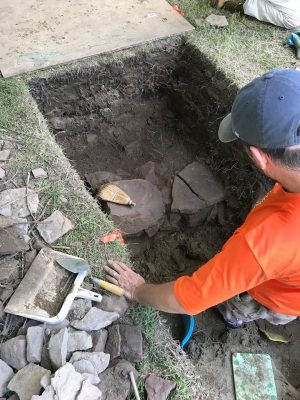
Site History
In the summer of 2017, the Connecticut Office of State Archaeology conducted public outreach excavations at two 17th Century house sites: the Oliver Ellsworth Homestead in Windsor and the Lt. John Hollister site in Glastonbury. Both excavations reflect the office’s ongoing effort to document early English settlement in the Connecticut River Valley. In coordination with the DAR who owns and manages the Ellsworth National Historic Landmark Site, OSA conducted its Archaeology Field School for Educators, followed by an open house week where the public was encouraged to drop by and help with the excavation. Work at the site focused on two areas of 17th Century occupation identified in 1990 by Robert Gradie. The Ellsworth site was first owned by one of Windsor’s most important early settlers, Francis Stiles. Stiles may have unloaded his vessel here as early as 1635 to prepare the property and construct houses for the “Lords and Gentlemen” who claimed rights to the land. The property was subdivided in 1640 and the north half occupied by the Gaylord family. In 1647 the Stiles parcel was sold and appears to have been owned as a rental property. Josiah Ellsworth first purchased and occupied the Stiles parcel in 1665. The lot stayed in the Ellsworth family through the 19th Century. Its most famous occupant, Oliver Ellsworth, the nation’s third chief justice and a drafter of the constitution, conducted major renovations in the 1780s, by which time the old Stiles house on the south lawn appears to have been demolished.
Radar Survey and Excavation in 2017
Ground penetrating radar was undertaken by Debbie Surabian of NRCS and two cellar-like features were identified where the Gaylord and Stiles houses were thought to exist. The Gaylord “cellar” unfortunately proved to be disturbance associated with an early 20th Century septic system, but the large (ca. 6x8m) Stiles lot cellar produced period-appropriate ceramics and clay pipe fragments. Excavation along the north wall of the filled cellar established that the original dry-laid foundation had been robbed-out to the bottom course of stone. The archaeology suggests a major episode of demolition at the site sometime before about 1740 (since the cellar fill lacked mid-18th C. English white salt-glazed stoneware and later ceramic types). The data raise new questions about the construction of the nearby Ellsworth mansion. Early interpretations of the house suggested a ca. 1740 date, matching the recent archaeology, but a later architectural assessment from the 1980s concluded the house was not built until the early 1780s. Perhaps both interpretations will prove to be true – with an initial construction about 1740 as the Ellsworth family was coming into its prosperity, and a later major renovation and expansion conducted when Oliver came into possession of the home in the 1780s.
GPR Survey at the Stiles-Ellsworth Site
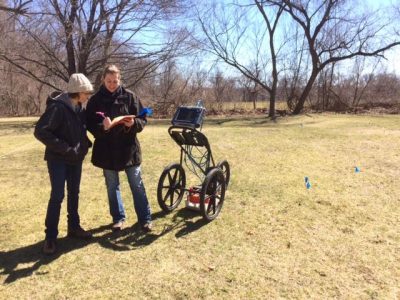
scissors
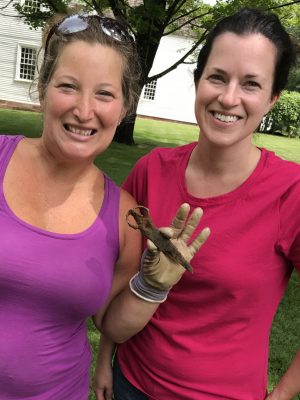
These scissors may date back to the period that Josiah Ellsworth worked as a weaver.
brass jetton
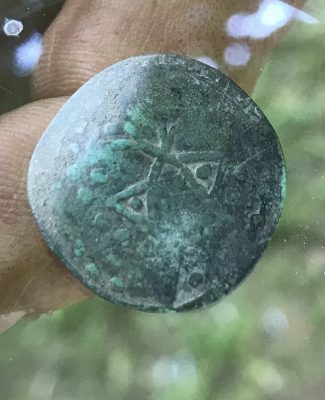
This brass jetton, or trade token, is of an unknown age. It may have been brought over by the Stiles party to be used as currency in the new colony.
dot ware
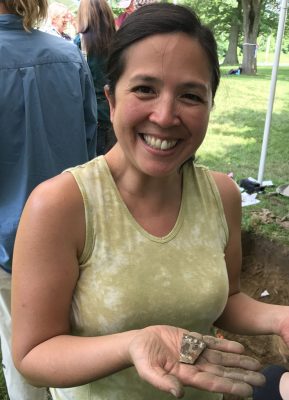
This earthenware sherd is decorated with slip dots and probably dates to the late 1600s.
small stone axe
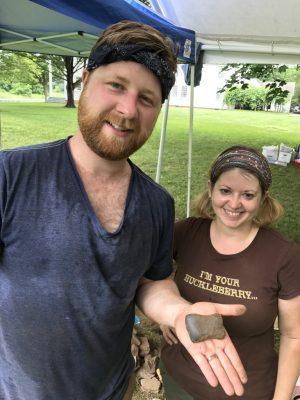
This small stone axe probably dates back to the Late Archaic period, about 4,000 years ago. This location near the Connecticut River had been occupied repeatedly for millennia.
knife bolster

This small brass ring or "bolster" probably anchored a knife blade into the handle.
black bead
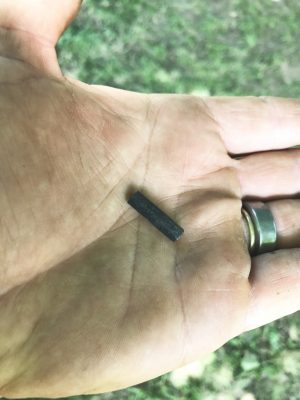
This glass trade bead may have been brought from England by Francis Stiles to trade with the local Native people. The Records of the Colony of Connecticut note that Stiles was accused of trading fire arms to the local Indians. The position of his house at the north end of the fledgling town placed him in a good position to conduct trade.